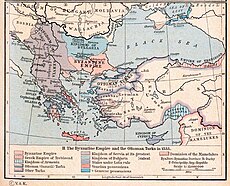Habsburg-occupied Serbia (1788–1791)
Koča's uprising Serbia Кочина крајина Kočina krajina | |||||||||||
|---|---|---|---|---|---|---|---|---|---|---|---|
| 1788–1791 | |||||||||||
Austro-Turkish War | 1788–1791 | ||||||||||
• Habsburg withdrawal, Treaty of Sistova | 1791 | ||||||||||
| ISO 3166 code | RS | ||||||||||
| |||||||||||
Koča's frontier (Serbian: Кочина крајина / Kočina krajina) refers to the Serbian territory established in the Sanjak of Smederevo, Ottoman Empire, during the Austro-Turkish War (1788–1791) in the 1788 . The Habsburg-organized Serbian Free Corps, among whom Koča Anđelković was a prominent captain (hence the historiographical name), initially held the central part of the sanjak, between February and September 7, 1791; after the Austrians entered the conflict the territory was expanded and became a Habsburg protectorate under military administration, called Serbia (German: Serbien). After the Austrian withdrawal and Treaty of Sistova (1791), the territory was regained by the Ottomans.
Background
Serbs
The Serbs had taken an active part in the wars fought in the Balkans against the Ottoman Empire, and also organized uprisings.[1] Because of this, they suffered persecution and their territories were devastated.[1] Major migrations from Serbia into Habsburg territory ensued.[1]
Habsburg-Russian alliance
Due to conflicts around Caucasus in 1786, relations between Russia and the Ottomans soured. The next year, Joseph II and Catherine II met in Crimea for the second time, which prompted the Ottomans to declare war on Russia.[2] In the meantime, the Austrians prepared the Serb refugees for war.
History
Koča's frontier rebellion


A
The Austrians entered this war in February 1788, though they had by now lost their best chance for an easy victory.[3] The slow preparations of Russia resulted in the Ottoman concentration on Belgrade.[4] The Austrians relied on Russian support in Moldavia, which only began in late 1788, and Joseph II seemed to have been reluctant to fight the Ottomans.[4] In July, the Ottomans crossed the Danube and broke into Austrian Banat.[4] Shortage of supplies struck both sides, while disease struck the Austrian soldiers.[4] As many as 50,000 Serb refugees flooded across the Danube, causing logistical problems for the Austrians.[4] In mid-August, Joseph II dispatched 20,400 soldiers into Banat.[4]
Habsburg occupation

On 8 October 1789, Ernst Gideon von Laudon took over Belgrade. Austrian forces occupied Serbia, and many Serbs fought in the Habsburg free corps, gaining organization and military skills.[5] The occupation was accompanied by the Catholic Church which sought to convert the Orthodox Serbs, which made the Serbs look to Russia for aid after the Ottoman regaining of the area in 1791.[5] By 1791 however the Austrians (the
Aftermath
After the war, the Ottomans gave rights to the Serbs to collect local taxes.
Legacy
An annual manifestation, the "Days for Koča's Frontier" (Дани Кочине крајине), takes place in Jagodina and Kladovo in honour of the rebellion.[7]
See also
| History of Serbia | |
|---|---|
 | |
| 1071–1217 | |
| Kingdom of Serbia | 1217–1346 |
| King Dragutin's realm | 1282–1325 |
| 1346–1371 | |
| Lordship of Prilep | 1371–1395 |
| Prince Lazar's Serbia | 1371–1402 |
| Vuk's Land | 1371–1412 |
| Despotate of Serbia | 1402–1537 |


